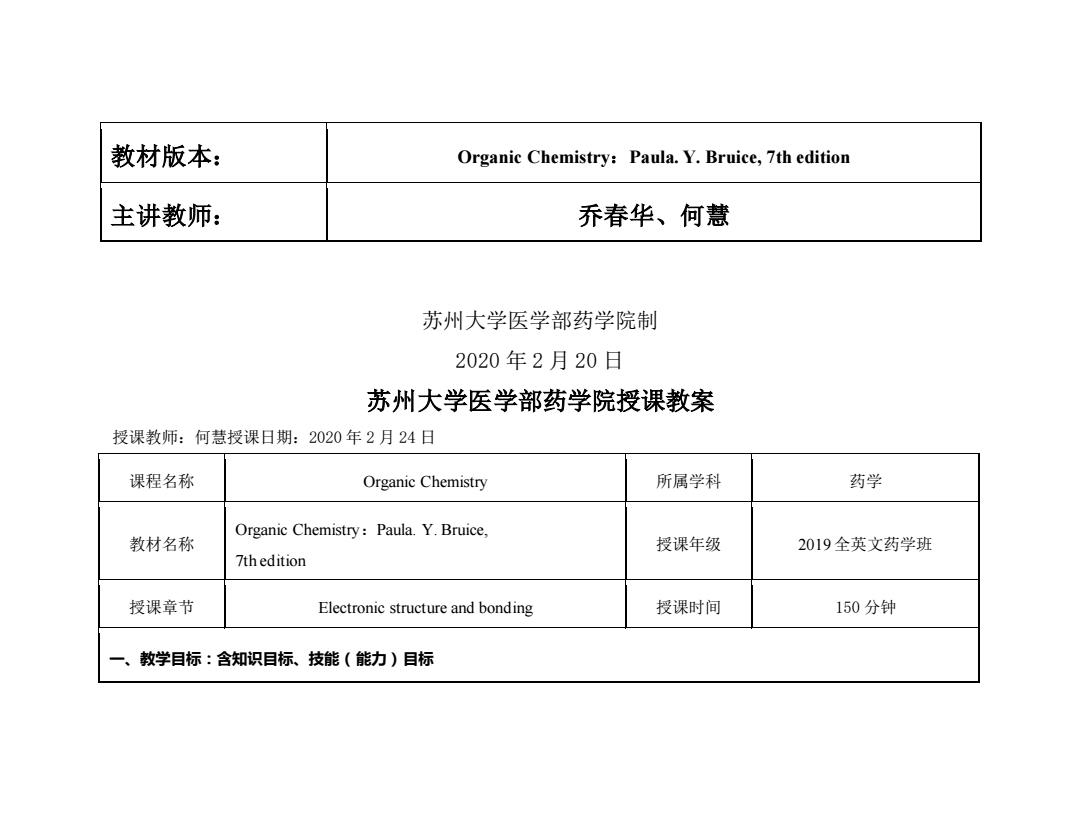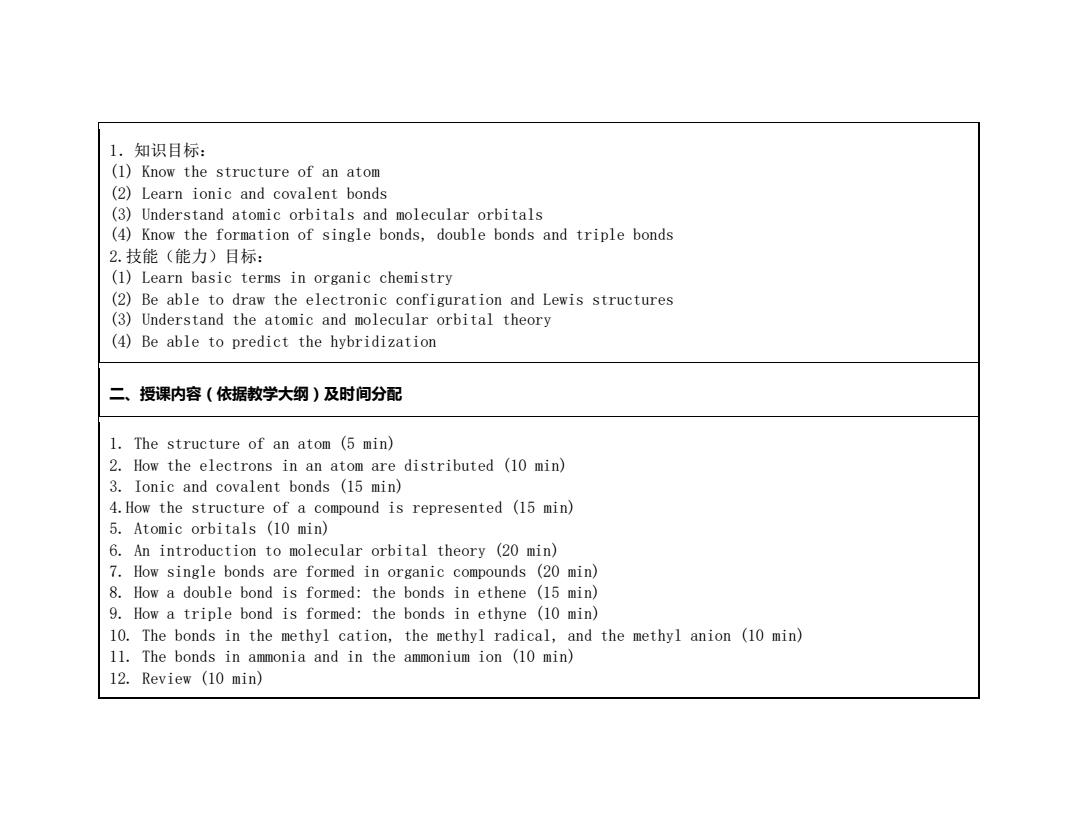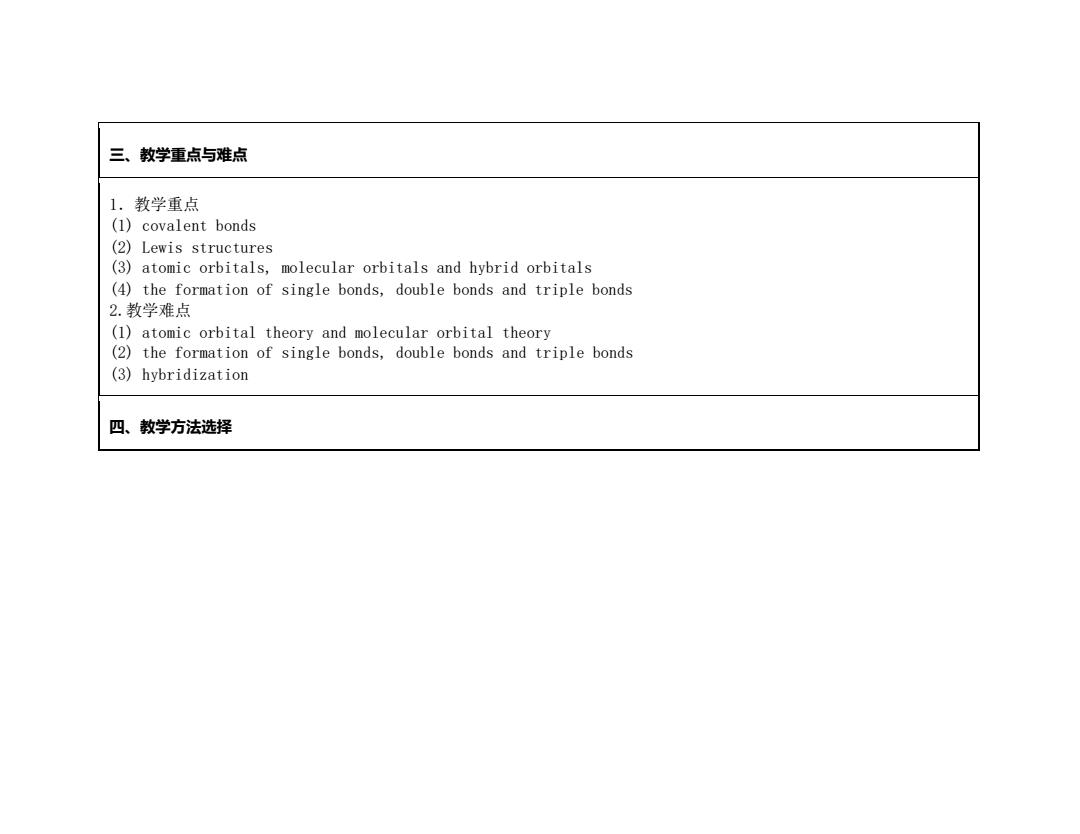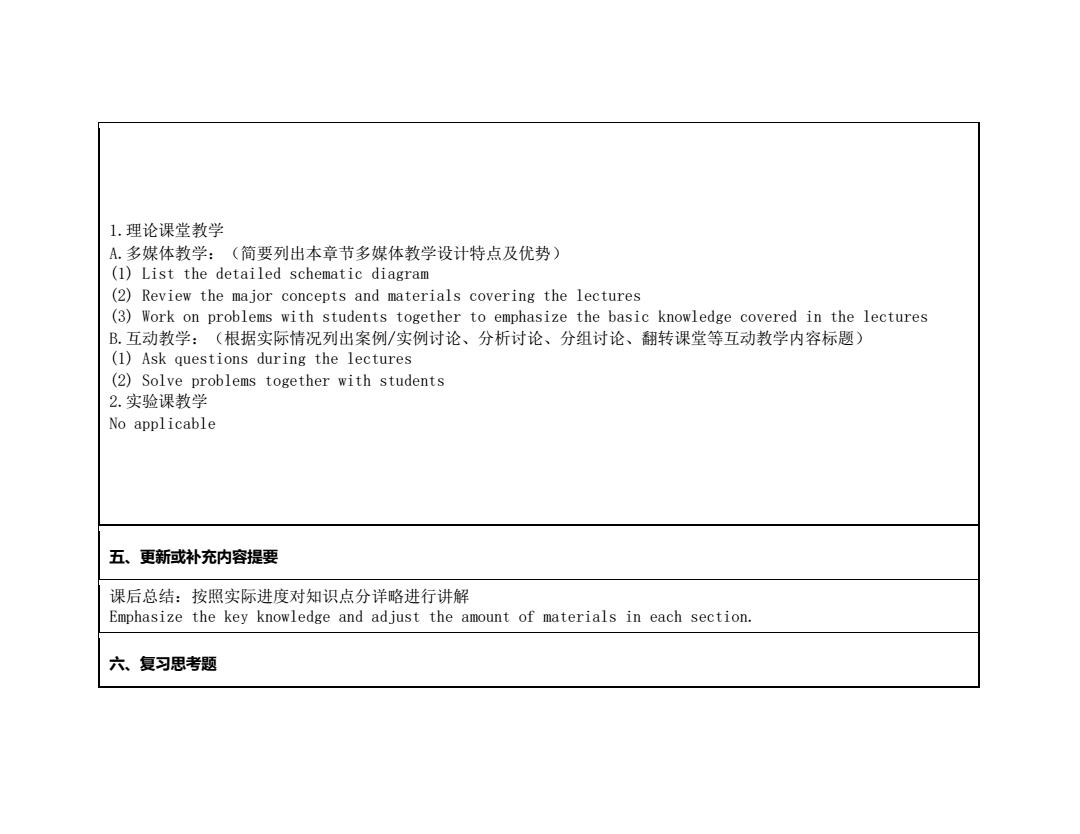
苏州大学医学部药学院 教 案 课程名称: Organic Chemistry 授课对象: 全英文药学班 授课学时: 90
苏州大学医学部药学院 教 案 课程名称: Organic Chemistry 授课对象: 全英文药学班 授课学时: 90

教材版本: Organic Chemistry:Paula.Y.Bruice,7th edition 主讲教师: 乔春华、何慧 苏州大学医学部药学院制 2020年2月20日 苏州大学医学部药学院授课教案 授课教师:何慧授课日期:2020年2月24日 课程名称 Organic Chemistry 所属学科 药学 Organic Chemistry:Paula.Y.Bruice, 教材名称 授课年级 2019全英文药学班 7th edition 授课章节 Electronic structure and bonding 授课时间 150分钟 一、教学目标:含知识目标、技能(能力)目标
教材版本: Organic Chemistry:Paula. Y. Bruice, 7th edition 主讲教师: 乔春华、何慧 苏州大学医学部药学院制 2020 年 2 月 20 日 苏州大学医学部药学院授课教案 授课教师:何慧授课日期:2020 年 2 月 24 日 课程名称 Organic Chemistry 所属学科 药学 教材名称 Organic Chemistry:Paula. Y. Bruice, 7th edition 授课年级 2019 全英文药学班 授课章节 Electronic structure and bonding 授课时间 150 分钟 一、教学目标:含知识目标、技能(能力)目标

1. 知识目标: (1)Know the structure of an atom (2)Learn ionic and covalent bonds (3)Understand atomic orbitals and molecular orbitals (4)Know the formation of single bonds,double bonds and triple bonds 2.技能(能力)目标: (1)Learn basic terms in organic chemistry (2)Be able to draw the electronic configuration and Lewis structures (3)Understand the atomic and molecular orbital theory (4)Be able to predict the hybridization 二、授课内容(依据教学大纲)及时间分配 1.The structure of an atom (5 min) 2.How the electrons in an atom are distributed (10 min) 3.Ionic and covalent bonds (15 min) 4.How the structure of a compound is represented (15 min) 5.Atomic orbitals (10 min) 6.An introduction to molecular orbital theory (20 min) 7.How single bonds are formed in organic compounds (20 min) 8.How a double bond is formed:the bonds in ethene (15 min) 9.How a triple bond is formed:the bonds in ethyne (10 min) 10.The bonds in the methyl cation,the methyl radical,and the methyl anion (10 min) 11.The bonds in ammonia and in the ammonium ion (10 min) 12.Review (10 min)
1.知识目标: (1) Know the structure of an atom (2) Learn ionic and covalent bonds (3) Understand atomic orbitals and molecular orbitals (4) Know the formation of single bonds, double bonds and triple bonds 2.技能(能力)目标: (1) Learn basic terms in organic chemistry (2) Be able to draw the electronic configuration and Lewis structures (3) Understand the atomic and molecular orbital theory (4) Be able to predict the hybridization 二、授课内容(依据教学大纲)及时间分配 1. The structure of an atom (5 min) 2. How the electrons in an atom are distributed (10 min) 3. Ionic and covalent bonds (15 min) 4.How the structure of a compound is represented (15 min) 5. Atomic orbitals (10 min) 6. An introduction to molecular orbital theory (20 min) 7. How single bonds are formed in organic compounds (20 min) 8. How a double bond is formed: the bonds in ethene (15 min) 9. How a triple bond is formed: the bonds in ethyne (10 min) 10. The bonds in the methyl cation, the methyl radical, and the methyl anion (10 min) 11. The bonds in ammonia and in the ammonium ion (10 min) 12. Review (10 min)

三、教学重点与难点 1.教学重点 (1)covalent bonds (2)Lewis structures (3)atomic orbitals,molecular orbitals and hybrid orbitals (4)the formation of single bonds,double bonds and triple bonds 2.教学难点 (1)atomic orbital theory and molecular orbital theory (2)the formation of single bonds,double bonds and triple bonds (3)hybridization 四、教学方法选择
三、教学重点与难点 1.教学重点 (1) covalent bonds (2) Lewis structures (3) atomic orbitals, molecular orbitals and hybrid orbitals (4) the formation of single bonds, double bonds and triple bonds 2.教学难点 (1) atomic orbital theory and molecular orbital theory (2) the formation of single bonds, double bonds and triple bonds (3) hybridization 四、教学方法选择

1.理论课堂教学 A.多媒体教学:(简要列出本章节多媒体教学设计特点及优势) (1)List the detailed schematic diagram (2)Review the major concepts and materials covering the lectures (3)Work on problems with students together to emphasize the basic knowledge covered in the lectures B.互动教学:(根据实际情况列出案例/实例讨论、分析讨论、分组讨论、翻转课堂等互动教学内容标题) (1)Ask questions during the lectures (2)Solve problems together with students 2.实验课教学 No applicable 五、更新或补充内容提要 课后总结:按照实际进度对知识点分详略进行讲解 Emphasize the key knowledge and adjust the amount of materials in each section. 六、复习思考题
1.理论课堂教学 A.多媒体教学:(简要列出本章节多媒体教学设计特点及优势) (1) List the detailed schematic diagram (2) Review the major concepts and materials covering the lectures (3) Work on problems with students together to emphasize the basic knowledge covered in the lectures B.互动教学:(根据实际情况列出案例/实例讨论、分析讨论、分组讨论、翻转课堂等互动教学内容标题) (1) Ask questions during the lectures (2) Solve problems together with students 2.实验课教学 No applicable 五、更新或补充内容提要 课后总结:按照实际进度对知识点分详略进行讲解 Emphasize the key knowledge and adjust the amount of materials in each section. 六、复习思考题